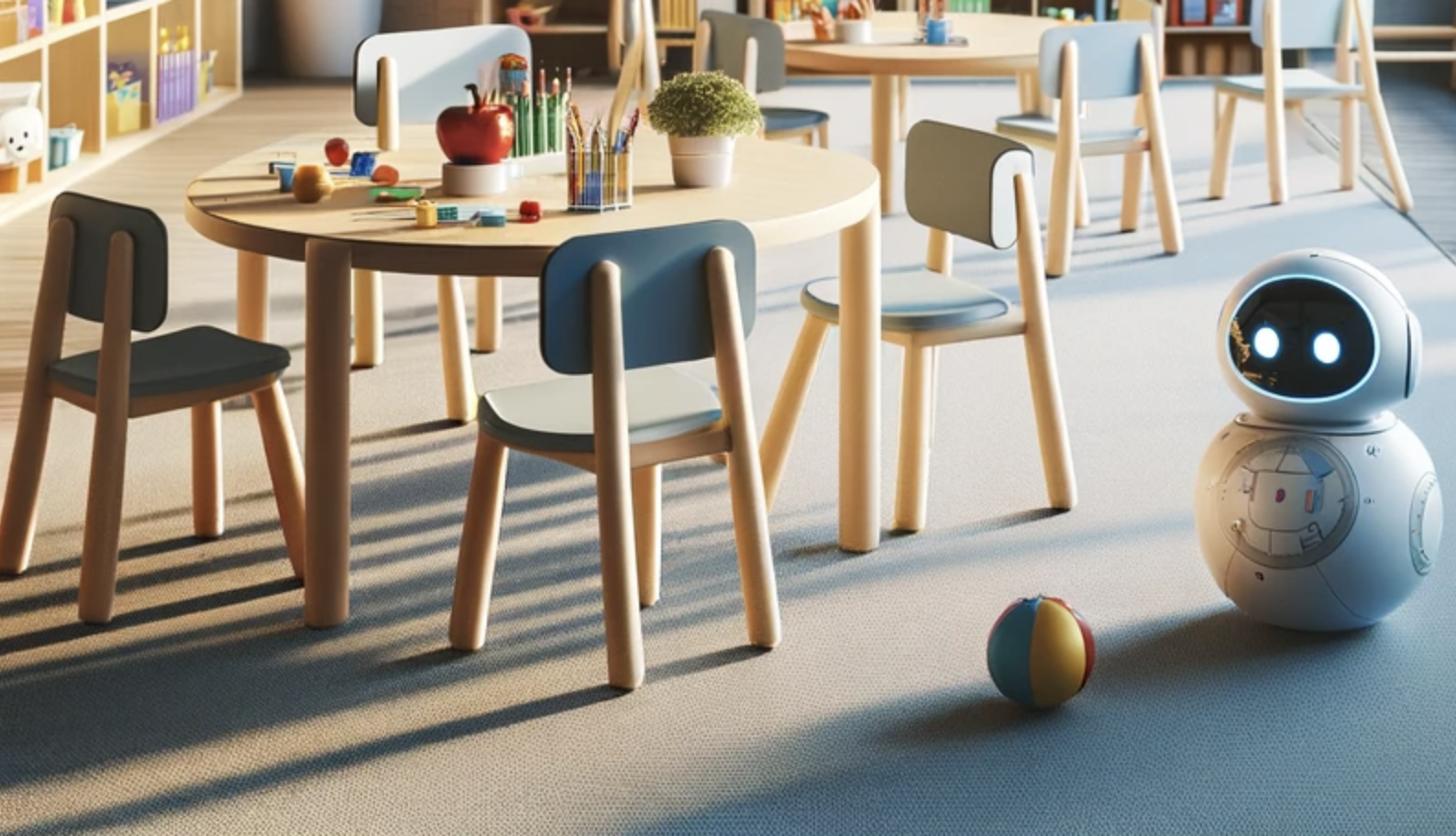How Can AI Best Serve Special Education Students? Let Me Count the Ways...
Jen, a neurodiverse student, struggles to communicate her needs. She wants to ask her teacher for an extension because she didn’t finish her homework. She asks an AI-powered robot in her classroom to present her with a few scenarios of how the conversation with her teacher might play out. Using role-playing, Jen is able to practice some communication strategies and ways to respond to possible questions from her teacher. Jen can practice and get feedback as many times as she wants with the robot. It doesn’t get tired!
Sarah, an ABA therapist who works with autistic students, creates a Task Analysis (TA) every time she needs to teach a student a new skill. A TA breaks down skills – such as hand washing – into small manageable steps. Using the new Task Analysis Creator platform developed by STAGES Learning, Sarah saves hours a week by typing into the AI-powered app any time she needs a new TA.
Samuel, a special education teacher, is teaching subtraction to a group of neurodiverse children with widely varying interests and abilities. He whips out his iPad and asks ChatGPT: “Give me a lesson plan that teaches subtraction using Marvel Super Heroes to a second-grade student with dyslexia.” Within seconds he has a lesson plan that includes using visuals of Spider-Man and his 8 webs as he uses 3 webs to swing. How many webs does Spider-Man have left?
What's Happening Right Now with AI and Special Education?
Generative artificial intelligence (AI) may be the best thing to happen to special education since 1975, when special education services were first mandated by law. As AI jumps into many areas of our lives – opening our phones with facial recognition, getting a movie recommendation, driving a smart car – we are just scraping the surface of what applications AI systems will have for teaching and learning.
For special education students, improvements are already taking place in personalized learning, enhanced access to learning materials, and automated processes for embedding Universal Design for Learning (UDL) into teaching practices. AI is also becoming a useful assistant to teachers and students and is augmenting the work of Behavioral Therapists, Speech Language Pathologists (SLPs), and Occupational Therapists (OTs).

Best Practices for Introducing AI in Schools: Humans in the Loop!
While some educators urge caution with using AI in the classroom, a new report issued by the Department of Education (DE) provides an overarching recommendation that can alleviate many concerns. The report emphasizes the need for teachers and other school personnel to be heavily involved in any educational processes using AI to guard against unintended consequences and ensure that these new technologies are beneficial for students and teachers. The report urges educators to always have humans in the loop when introducing any new AI tools.
AI is not a replacement for educators. Its purpose is to augment and enhance the work of teachers and specialists freeing up their time to maximize face-to-face contact with students. Thoughtful implementation of AI also involves training to make sure educators are up to speed on how to avoid potential bias in AI and “hallucinations” (false or made-up content) that AI can sometimes produce, and to ensure student data is protected.
The DE urges us to view technology-enhanced education as:
...more like an electric bike and less like robot vacuums. On an electric bike, the human is fully aware and fully in control, but their burden is less, and their effort is multiplied by a complementary technological enhancement.1
The Four Most Popular Ways AI is Being Used in Special Education
1. AI is Enhancing Personalized Learning
One of the most important contributions AI is already making to special education is enhancing personalized learning experiences for all students, and especially for students with special needs. Learning platforms can now incorporate AI that analyzes student performance and provides individualized learning pathways by offering the right amount of content, support, and activities to reinforce learning at point of need. Intelligent tutoring systems give each student individualized guidance, feedback, customized help, and practice exercises tailored to their needs. For neurodiverse students, who are often atypical learners, this personalized guidance can be essential to successful learning.
AI can also increase engagement by using a student’s interests to recommend learning resources, books, videos, and other tools that will help keep a student’s attention and increase engagement. New natural language processing (NLP) tools are being developed that can provide students with virtual assistants and chatbots that can interact with students by answering questions and providing feedback and encouragement to help keep students on track.
2. AI is Providing Greater Access to Learning Materials
AI can greatly enhance access to learning resources by translating text into speech for visually impaired students or interpreting speech into text for students who are hearing-impaired. Students with dyslexia or other reading and language challenges can also benefit from text to speech when they need to learn content quickly and their reading challenges are delaying that process. AI can also be used to convert textbooks into audio books and provide subtitles for videos to enhance learning.
AI tools can embed Universal Design for Learning (UDL) into many learning experiences by helping teachers adapt lesson plans to enable learners to choose their preferred ways of engaging with content. UDL provides students with multiple ways to engage with content and express their understanding. Translating a lesson plan into multiple adaptations can be time-consuming for a teacher. AI can assist in making these adjustments.

3. AI is Serving as a Teaching Assistant
An AI assistant can lighten the load for teachers by performing repetitive tasks such as analyzing student data and grading quizzes to provide teachers with appropriate customized interventions for students. Teachers can focus on evaluating more complex student projects and essays and spend more time interacting with small groups or one-on-one with students.
AI can also assist students by serving as a “guide on the side” and interacting verbally by providing scaffolding and feedback at point of need. Embedded AI can assist with formative evaluations to give feedback to students before they choose a wrong answer so that specific mistakes or steps in a process can be immediately remedied.
4. AI is Augmenting the Work of Specialists
Behavioral Therapists/ABA Therapists
Autistic students and students with intellectual or developmental disabilities often need highly personalized treatment plans that involve data collection, problem behavior identification, pattern analysis, and categorization in order to predict outcomes and develop effective treatment plans.
AI algorithms can aid behavioral therapists in developing personalized treatment plans and creating learning tools that can target and promote self-regulation behaviors and improve the quality of interventions. For example, AI can analyze data from a student’s past behavior to identify potential triggers for disruptive behavior. This provides behavioral therapists with ways to reduce those triggers and better manage challenging behaviors.
The need for human therapists remains central to ABA therapy, but many of the routine tasks these therapists perform can be taken over by intelligent agents. Intuitive and user-friendly platforms created by STAGES– such as the Task Analysis Creator referenced above, the Positive Behavior Buddy that provides guidance on autism support strategies, and the IEP Goal Writer – can save therapists hours a week. These and other AI-powered teaching tools are available for free at STAGES Language Builder Custom GPTs.
AI can also dramatically scale up the amount of data that can be monitored and analyzed. Large data sets can be reviewed within seconds to discover patterns and recommend interventions. For example, AI tools can review hours of video that record a student’s behavior and then provide a scatterplot analysis in under a minute to inform instructional activities going forward.
Speech Language Pathologists (SLPs)
AI apps are being developed that can analyze a student’s speech patterns, pinpoint areas that need improvement, and present personalized learning activities to help students improve their speech and language skills. AI can also provide immediate feedback on pronunciation to customize speech therapy and provide an analysis of student progress. For some students who feel self-conscious about their language abilities, AI provides them with a safe space to practice until they feel more comfortable working directly with a specialist and participating in student groups.
As AI takes over some of the more routine aspects of an SLP’s workload, such as documentation and data keeping, the specialist can focus on spending more time directly with students. AI can also strengthen the connection between specialists and parents by providing families with tools to use at home that carefully supplement and reinforce what the child is learning at school.
Occupational Therapists
AI can assist OT’s in creating personalized plans for students with special needs and can monitor student progress and provide ongoing feedback and corrective suggestions. AI-powered physical therapy games can provide engaging experiences for students and can be customized to connect with a student’s interests and abilities. ChatGPT, for example, can respond to a therapist prompt: “What are some therapeutic activities to improve gross motor skills for an autistic student in Kindergarten who likes playing with toy cars?”
AI can assist OT’s in diagnosing and informing therapeutic choices for students. Recent research used AI to assess preschooler’s abilities and progress with visual-motor coordination when engaging in coloring, copying, and folding origami. Copying and origami activities were found to be strongly associated with being able to assess and improve children’s visual-motor coordination.2 OT’s can now use these two activities to address visual-motor skill development among preschool children and measure their improvement.

Next Steps in AI and Special Education
New AI-enabled systems need to focus on how to serve a diverse group of learners and accommodate a multitude of instructional strategies. Any AI used in schools needs to ensure that educators are involved in decisions impacting adoption and implementation. In any AI proposal we need to ask: Is this specific use of AI benefiting learners and educators? In addition, new research needs to work to enhance safety and data privacy and reduce or avoid possible bias and unintended consequences in AI-enabled platforms.
Are you using AI in Special Education? Please tell us about it below!
1. U.S. Department of Education, Office of Educational Technology, Artificial Intelligence and Future of Teaching and Learning: Insights and Recommendations, Washington, DC, 2023. https://tech.ed.gov/ai-future-of-teaching-and-learning/
2. Chien-Yu Huang, Yen-Ting Yu, Kuan-Lin Chen, Gong-Hong Lin, Ching-Lin Hsieh; Using Artificial Intelligence to Identify the Associations of Children’s Performance of Coloring, Origami, and Copying Activities With Visual–Motor Integration. Am J Occup Ther September/October 2023, Vol. 77(5), 7705205080. doi: https://doi.org/10.5014/ajot.2023.050210

L.F. Stebbins, M.Ed. M.L.I.S.
L.F. Stebbins has more than twenty-five years of experience in higher education with a background in library and information science, instructional design, research, and teaching. She has an M.Ed. from the Technology Innovation & Education Program at the Harvard Graduate School of Education and a Masters in Information Science from Simmons College. For twenty years she created and led media literacy and research skills programs for students and faculty at Brandeis University. Currently she is the Director at research4Ed.com and the Director for Research at Consulting Services for Education (CS4Ed). For more about Leslie visit LeslieStebbins.com.




